Enterprise Environmental Factors Analysis: PROJ6001 Report
VerifiedAdded on 2022/11/13
|15
|3117
|1
Report
AI Summary
This report provides a comprehensive analysis of enterprise environmental factors (EEFs), crucial elements that can significantly impact project management processes and outcomes. It begins by defining and differentiating between internal and external EEFs, detailing factors such as employees, budget, corporate culture, and organizational structure as internal influences, and demographic, economic, political, ecological, socio-cultural, and technological factors as external influences. The report then explores various development strategies project managers can adopt, including profiling the project, deciding on and justifying the approach, and describing requirements. Furthermore, it outlines a drafted communication plan designed to manage stakeholder expectations and ensure effective information flow throughout a project's lifecycle, including a communication plan matrix. The reflection section highlights the importance of EEFs and their impact on project success, emphasizing the project manager's role in planning, designing, and executing projects effectively, along with the importance of stakeholders and well-structured communication. The document concludes with a personal reflection on the learning experience and how the acquired knowledge will benefit the student in future project management endeavors.
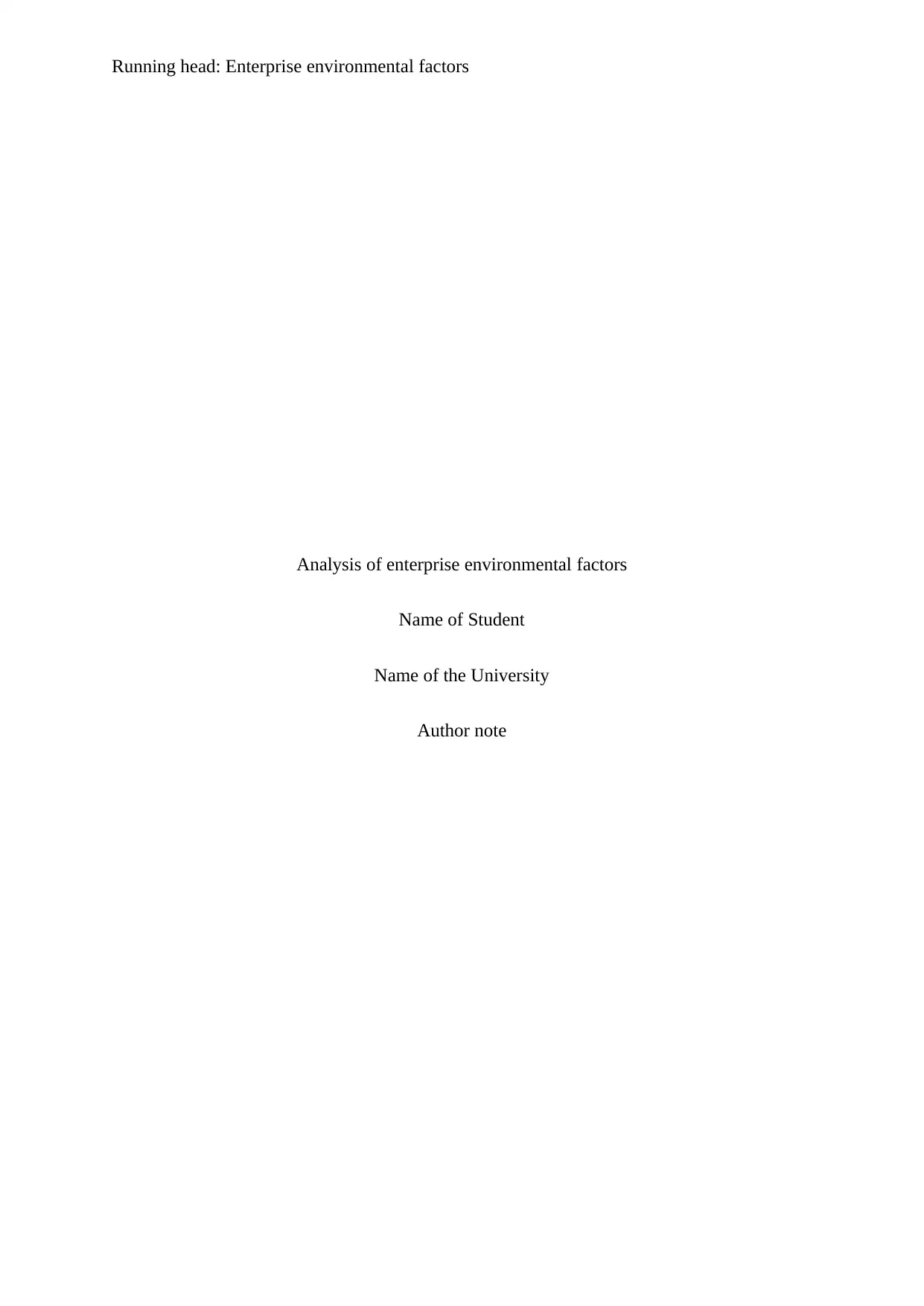
Running head: Enterprise environmental factors
Analysis of enterprise environmental factors
Name of Student
Name of the University
Author note
Analysis of enterprise environmental factors
Name of Student
Name of the University
Author note
Paraphrase This Document
Need a fresh take? Get an instant paraphrase of this document with our AI Paraphraser
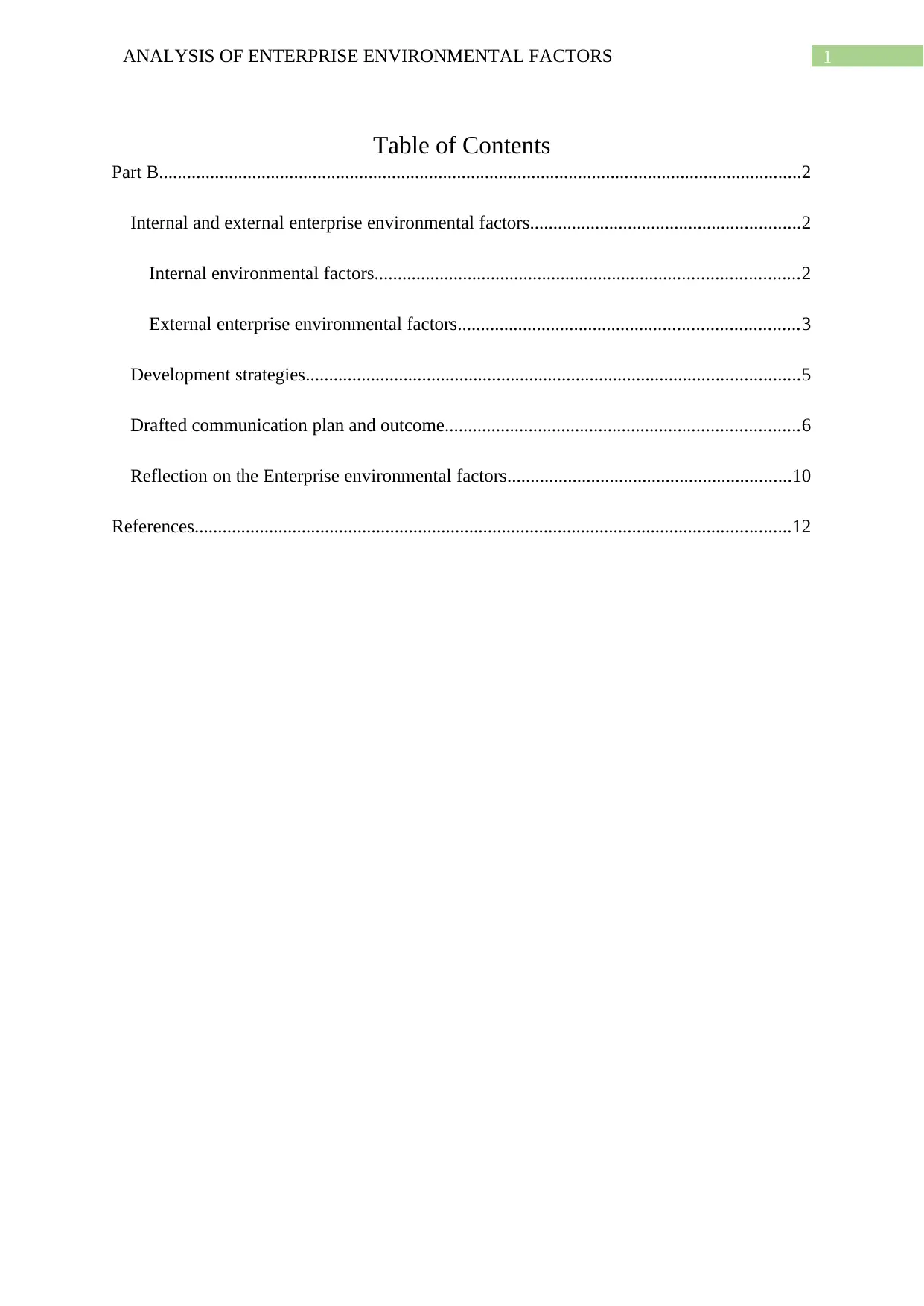
1ANALYSIS OF ENTERPRISE ENVIRONMENTAL FACTORS
Table of Contents
Part B..........................................................................................................................................2
Internal and external enterprise environmental factors..........................................................2
Internal environmental factors...........................................................................................2
External enterprise environmental factors.........................................................................3
Development strategies..........................................................................................................5
Drafted communication plan and outcome............................................................................6
Reflection on the Enterprise environmental factors.............................................................10
References................................................................................................................................12
Table of Contents
Part B..........................................................................................................................................2
Internal and external enterprise environmental factors..........................................................2
Internal environmental factors...........................................................................................2
External enterprise environmental factors.........................................................................3
Development strategies..........................................................................................................5
Drafted communication plan and outcome............................................................................6
Reflection on the Enterprise environmental factors.............................................................10
References................................................................................................................................12
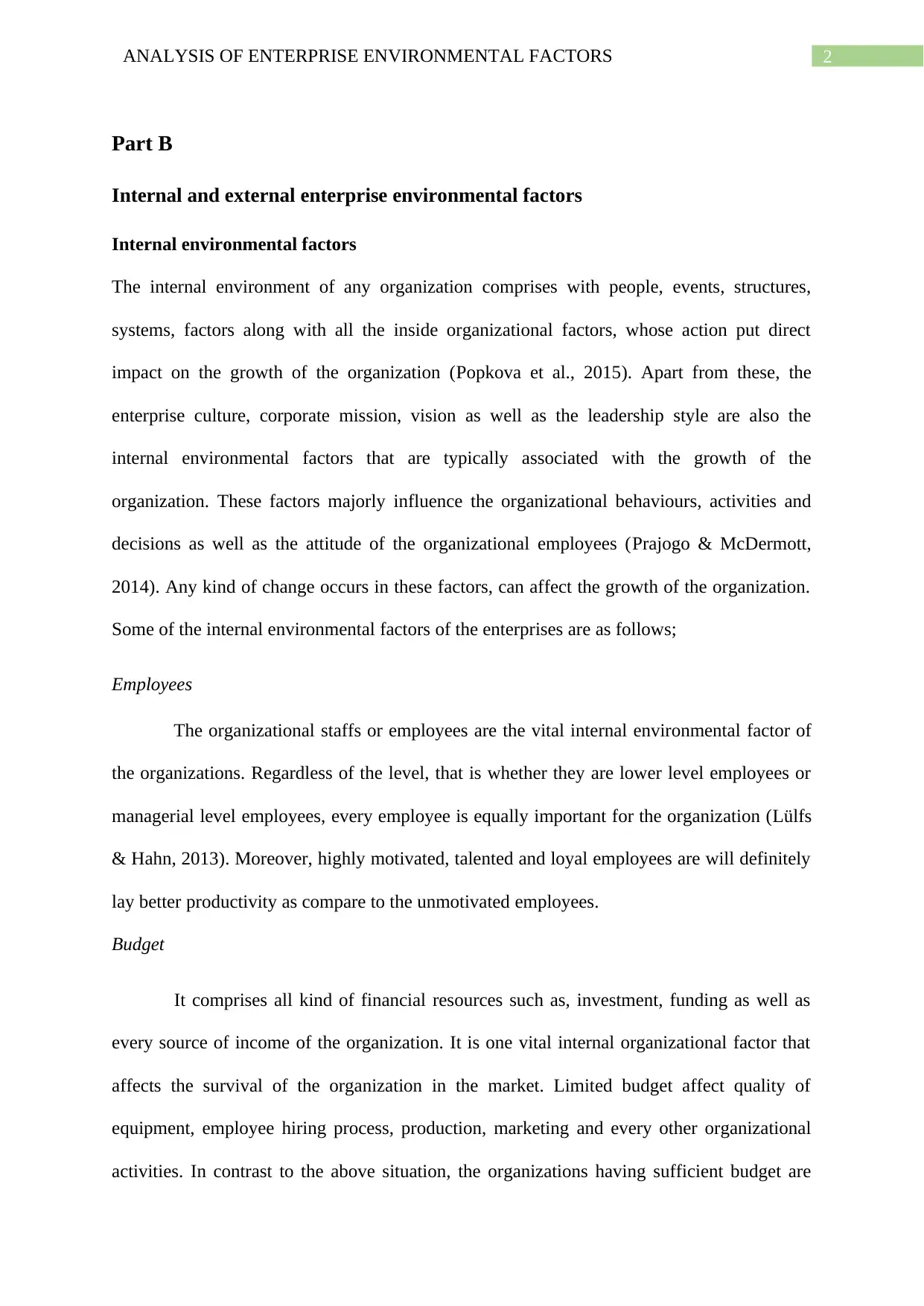
2ANALYSIS OF ENTERPRISE ENVIRONMENTAL FACTORS
Part B
Internal and external enterprise environmental factors
Internal environmental factors
The internal environment of any organization comprises with people, events, structures,
systems, factors along with all the inside organizational factors, whose action put direct
impact on the growth of the organization (Popkova et al., 2015). Apart from these, the
enterprise culture, corporate mission, vision as well as the leadership style are also the
internal environmental factors that are typically associated with the growth of the
organization. These factors majorly influence the organizational behaviours, activities and
decisions as well as the attitude of the organizational employees (Prajogo & McDermott,
2014). Any kind of change occurs in these factors, can affect the growth of the organization.
Some of the internal environmental factors of the enterprises are as follows;
Employees
The organizational staffs or employees are the vital internal environmental factor of
the organizations. Regardless of the level, that is whether they are lower level employees or
managerial level employees, every employee is equally important for the organization (Lülfs
& Hahn, 2013). Moreover, highly motivated, talented and loyal employees are will definitely
lay better productivity as compare to the unmotivated employees.
Budget
It comprises all kind of financial resources such as, investment, funding as well as
every source of income of the organization. It is one vital internal organizational factor that
affects the survival of the organization in the market. Limited budget affect quality of
equipment, employee hiring process, production, marketing and every other organizational
activities. In contrast to the above situation, the organizations having sufficient budget are
Part B
Internal and external enterprise environmental factors
Internal environmental factors
The internal environment of any organization comprises with people, events, structures,
systems, factors along with all the inside organizational factors, whose action put direct
impact on the growth of the organization (Popkova et al., 2015). Apart from these, the
enterprise culture, corporate mission, vision as well as the leadership style are also the
internal environmental factors that are typically associated with the growth of the
organization. These factors majorly influence the organizational behaviours, activities and
decisions as well as the attitude of the organizational employees (Prajogo & McDermott,
2014). Any kind of change occurs in these factors, can affect the growth of the organization.
Some of the internal environmental factors of the enterprises are as follows;
Employees
The organizational staffs or employees are the vital internal environmental factor of
the organizations. Regardless of the level, that is whether they are lower level employees or
managerial level employees, every employee is equally important for the organization (Lülfs
& Hahn, 2013). Moreover, highly motivated, talented and loyal employees are will definitely
lay better productivity as compare to the unmotivated employees.
Budget
It comprises all kind of financial resources such as, investment, funding as well as
every source of income of the organization. It is one vital internal organizational factor that
affects the survival of the organization in the market. Limited budget affect quality of
equipment, employee hiring process, production, marketing and every other organizational
activities. In contrast to the above situation, the organizations having sufficient budget are
⊘ This is a preview!⊘
Do you want full access?
Subscribe today to unlock all pages.

Trusted by 1+ million students worldwide
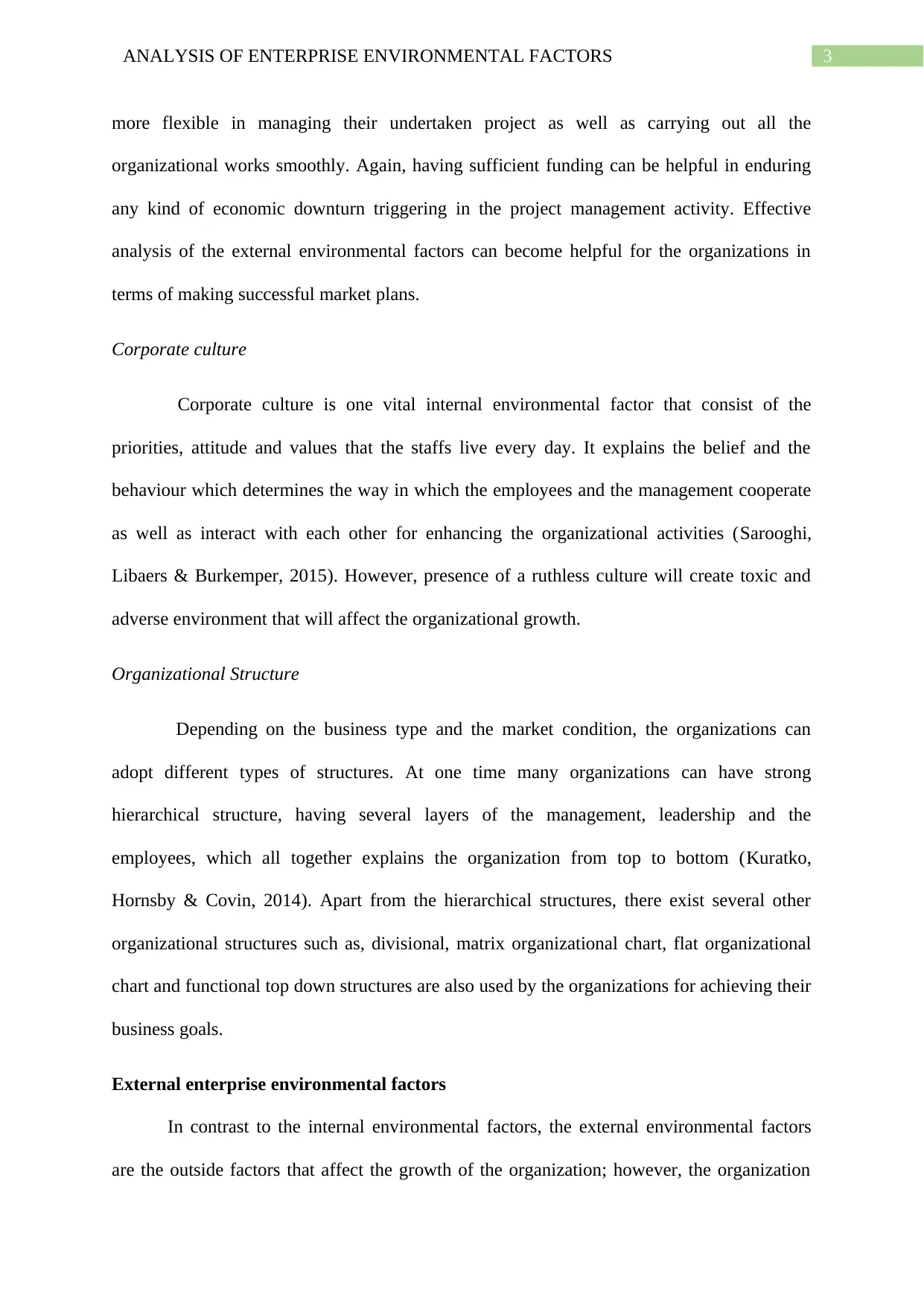
3ANALYSIS OF ENTERPRISE ENVIRONMENTAL FACTORS
more flexible in managing their undertaken project as well as carrying out all the
organizational works smoothly. Again, having sufficient funding can be helpful in enduring
any kind of economic downturn triggering in the project management activity. Effective
analysis of the external environmental factors can become helpful for the organizations in
terms of making successful market plans.
Corporate culture
Corporate culture is one vital internal environmental factor that consist of the
priorities, attitude and values that the staffs live every day. It explains the belief and the
behaviour which determines the way in which the employees and the management cooperate
as well as interact with each other for enhancing the organizational activities (Sarooghi,
Libaers & Burkemper, 2015). However, presence of a ruthless culture will create toxic and
adverse environment that will affect the organizational growth.
Organizational Structure
Depending on the business type and the market condition, the organizations can
adopt different types of structures. At one time many organizations can have strong
hierarchical structure, having several layers of the management, leadership and the
employees, which all together explains the organization from top to bottom (Kuratko,
Hornsby & Covin, 2014). Apart from the hierarchical structures, there exist several other
organizational structures such as, divisional, matrix organizational chart, flat organizational
chart and functional top down structures are also used by the organizations for achieving their
business goals.
External enterprise environmental factors
In contrast to the internal environmental factors, the external environmental factors
are the outside factors that affect the growth of the organization; however, the organization
more flexible in managing their undertaken project as well as carrying out all the
organizational works smoothly. Again, having sufficient funding can be helpful in enduring
any kind of economic downturn triggering in the project management activity. Effective
analysis of the external environmental factors can become helpful for the organizations in
terms of making successful market plans.
Corporate culture
Corporate culture is one vital internal environmental factor that consist of the
priorities, attitude and values that the staffs live every day. It explains the belief and the
behaviour which determines the way in which the employees and the management cooperate
as well as interact with each other for enhancing the organizational activities (Sarooghi,
Libaers & Burkemper, 2015). However, presence of a ruthless culture will create toxic and
adverse environment that will affect the organizational growth.
Organizational Structure
Depending on the business type and the market condition, the organizations can
adopt different types of structures. At one time many organizations can have strong
hierarchical structure, having several layers of the management, leadership and the
employees, which all together explains the organization from top to bottom (Kuratko,
Hornsby & Covin, 2014). Apart from the hierarchical structures, there exist several other
organizational structures such as, divisional, matrix organizational chart, flat organizational
chart and functional top down structures are also used by the organizations for achieving their
business goals.
External enterprise environmental factors
In contrast to the internal environmental factors, the external environmental factors
are the outside factors that affect the growth of the organization; however, the organization
Paraphrase This Document
Need a fresh take? Get an instant paraphrase of this document with our AI Paraphraser
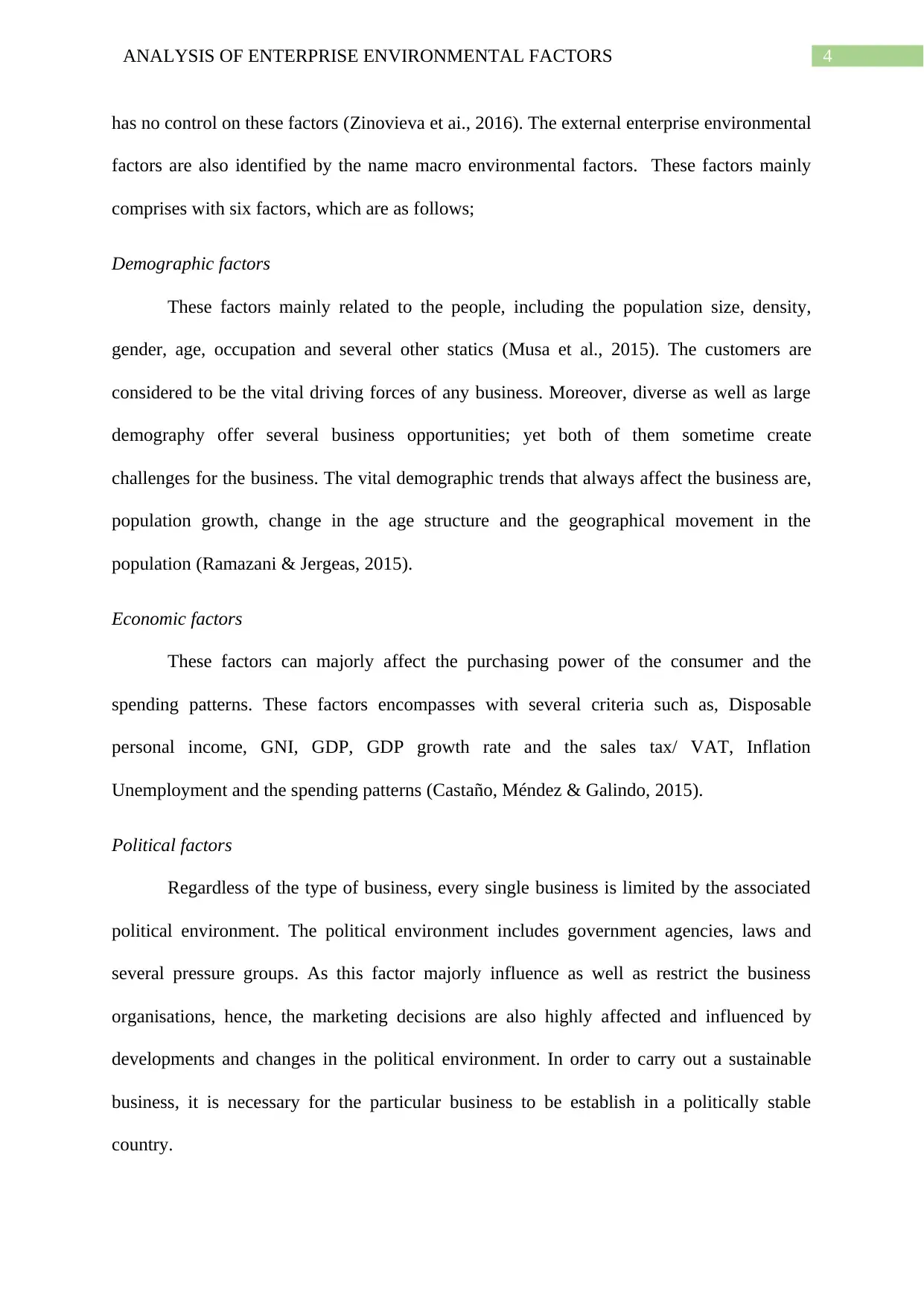
4ANALYSIS OF ENTERPRISE ENVIRONMENTAL FACTORS
has no control on these factors (Zinovieva et ai., 2016). The external enterprise environmental
factors are also identified by the name macro environmental factors. These factors mainly
comprises with six factors, which are as follows;
Demographic factors
These factors mainly related to the people, including the population size, density,
gender, age, occupation and several other statics (Musa et al., 2015). The customers are
considered to be the vital driving forces of any business. Moreover, diverse as well as large
demography offer several business opportunities; yet both of them sometime create
challenges for the business. The vital demographic trends that always affect the business are,
population growth, change in the age structure and the geographical movement in the
population (Ramazani & Jergeas, 2015).
Economic factors
These factors can majorly affect the purchasing power of the consumer and the
spending patterns. These factors encompasses with several criteria such as, Disposable
personal income, GNI, GDP, GDP growth rate and the sales tax/ VAT, Inflation
Unemployment and the spending patterns (Castaño, Méndez & Galindo, 2015).
Political factors
Regardless of the type of business, every single business is limited by the associated
political environment. The political environment includes government agencies, laws and
several pressure groups. As this factor majorly influence as well as restrict the business
organisations, hence, the marketing decisions are also highly affected and influenced by
developments and changes in the political environment. In order to carry out a sustainable
business, it is necessary for the particular business to be establish in a politically stable
country.
has no control on these factors (Zinovieva et ai., 2016). The external enterprise environmental
factors are also identified by the name macro environmental factors. These factors mainly
comprises with six factors, which are as follows;
Demographic factors
These factors mainly related to the people, including the population size, density,
gender, age, occupation and several other statics (Musa et al., 2015). The customers are
considered to be the vital driving forces of any business. Moreover, diverse as well as large
demography offer several business opportunities; yet both of them sometime create
challenges for the business. The vital demographic trends that always affect the business are,
population growth, change in the age structure and the geographical movement in the
population (Ramazani & Jergeas, 2015).
Economic factors
These factors can majorly affect the purchasing power of the consumer and the
spending patterns. These factors encompasses with several criteria such as, Disposable
personal income, GNI, GDP, GDP growth rate and the sales tax/ VAT, Inflation
Unemployment and the spending patterns (Castaño, Méndez & Galindo, 2015).
Political factors
Regardless of the type of business, every single business is limited by the associated
political environment. The political environment includes government agencies, laws and
several pressure groups. As this factor majorly influence as well as restrict the business
organisations, hence, the marketing decisions are also highly affected and influenced by
developments and changes in the political environment. In order to carry out a sustainable
business, it is necessary for the particular business to be establish in a politically stable
country.
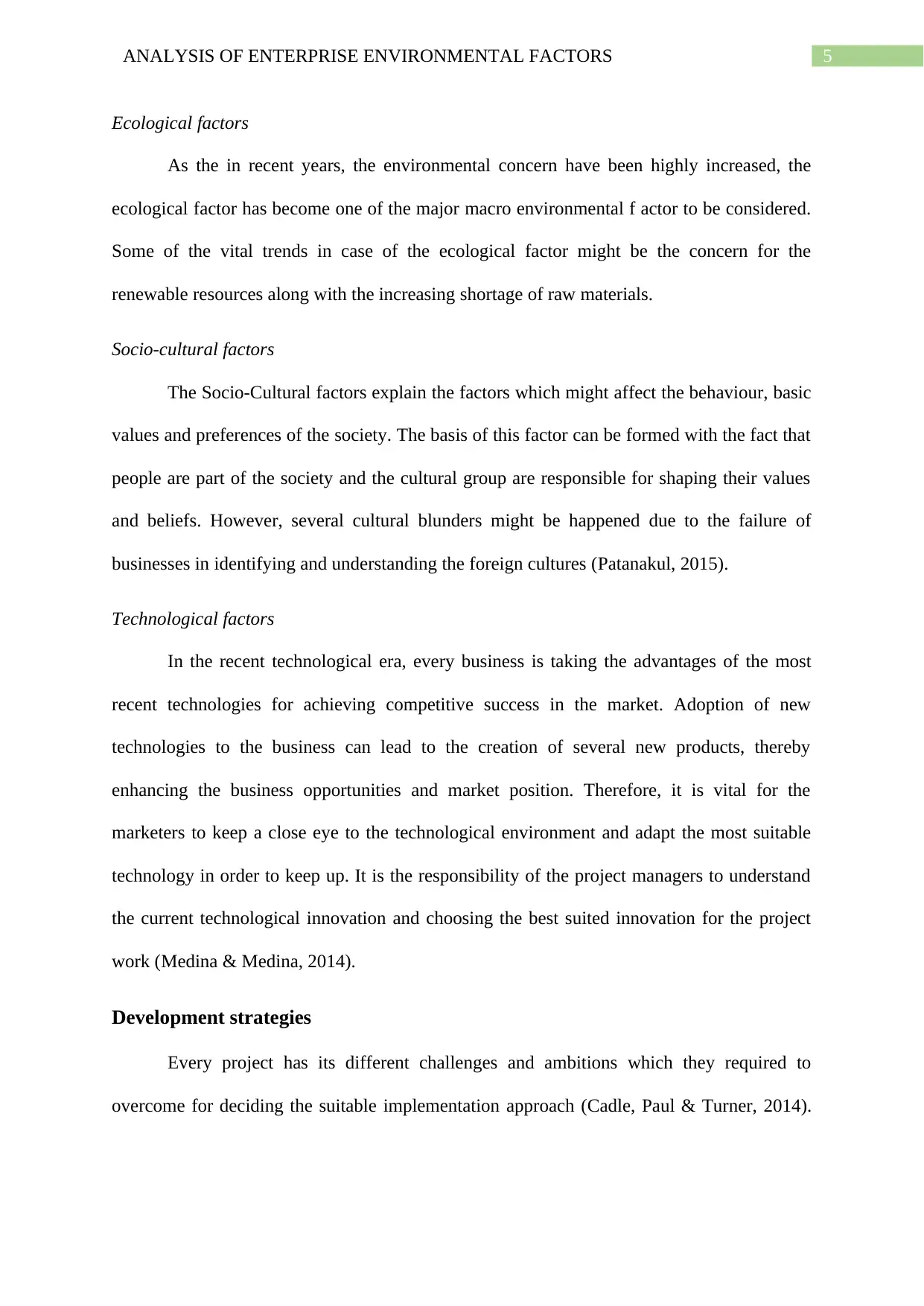
5ANALYSIS OF ENTERPRISE ENVIRONMENTAL FACTORS
Ecological factors
As the in recent years, the environmental concern have been highly increased, the
ecological factor has become one of the major macro environmental f actor to be considered.
Some of the vital trends in case of the ecological factor might be the concern for the
renewable resources along with the increasing shortage of raw materials.
Socio-cultural factors
The Socio-Cultural factors explain the factors which might affect the behaviour, basic
values and preferences of the society. The basis of this factor can be formed with the fact that
people are part of the society and the cultural group are responsible for shaping their values
and beliefs. However, several cultural blunders might be happened due to the failure of
businesses in identifying and understanding the foreign cultures (Patanakul, 2015).
Technological factors
In the recent technological era, every business is taking the advantages of the most
recent technologies for achieving competitive success in the market. Adoption of new
technologies to the business can lead to the creation of several new products, thereby
enhancing the business opportunities and market position. Therefore, it is vital for the
marketers to keep a close eye to the technological environment and adapt the most suitable
technology in order to keep up. It is the responsibility of the project managers to understand
the current technological innovation and choosing the best suited innovation for the project
work (Medina & Medina, 2014).
Development strategies
Every project has its different challenges and ambitions which they required to
overcome for deciding the suitable implementation approach (Cadle, Paul & Turner, 2014).
Ecological factors
As the in recent years, the environmental concern have been highly increased, the
ecological factor has become one of the major macro environmental f actor to be considered.
Some of the vital trends in case of the ecological factor might be the concern for the
renewable resources along with the increasing shortage of raw materials.
Socio-cultural factors
The Socio-Cultural factors explain the factors which might affect the behaviour, basic
values and preferences of the society. The basis of this factor can be formed with the fact that
people are part of the society and the cultural group are responsible for shaping their values
and beliefs. However, several cultural blunders might be happened due to the failure of
businesses in identifying and understanding the foreign cultures (Patanakul, 2015).
Technological factors
In the recent technological era, every business is taking the advantages of the most
recent technologies for achieving competitive success in the market. Adoption of new
technologies to the business can lead to the creation of several new products, thereby
enhancing the business opportunities and market position. Therefore, it is vital for the
marketers to keep a close eye to the technological environment and adapt the most suitable
technology in order to keep up. It is the responsibility of the project managers to understand
the current technological innovation and choosing the best suited innovation for the project
work (Medina & Medina, 2014).
Development strategies
Every project has its different challenges and ambitions which they required to
overcome for deciding the suitable implementation approach (Cadle, Paul & Turner, 2014).
⊘ This is a preview!⊘
Do you want full access?
Subscribe today to unlock all pages.

Trusted by 1+ million students worldwide
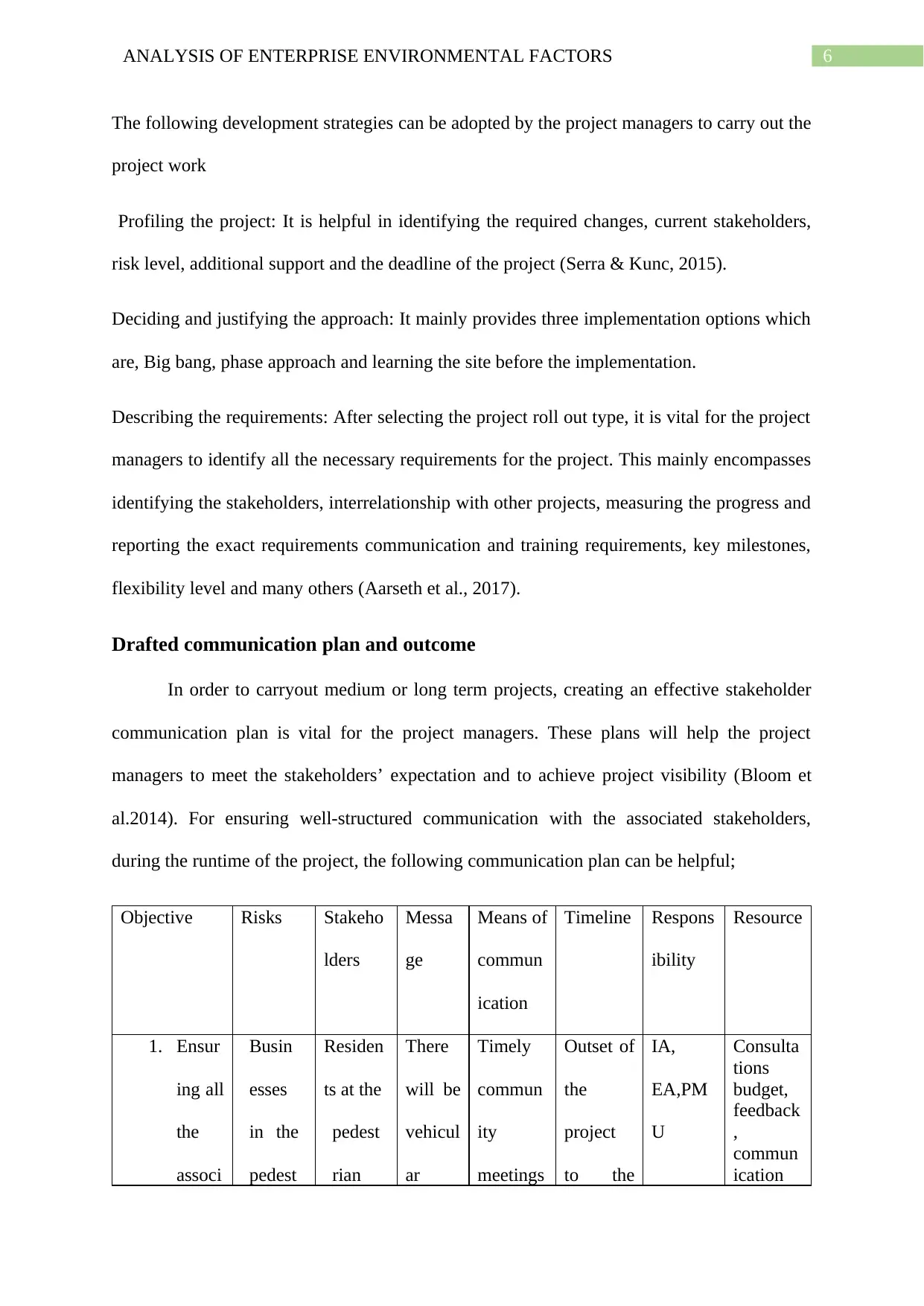
6ANALYSIS OF ENTERPRISE ENVIRONMENTAL FACTORS
The following development strategies can be adopted by the project managers to carry out the
project work
Profiling the project: It is helpful in identifying the required changes, current stakeholders,
risk level, additional support and the deadline of the project (Serra & Kunc, 2015).
Deciding and justifying the approach: It mainly provides three implementation options which
are, Big bang, phase approach and learning the site before the implementation.
Describing the requirements: After selecting the project roll out type, it is vital for the project
managers to identify all the necessary requirements for the project. This mainly encompasses
identifying the stakeholders, interrelationship with other projects, measuring the progress and
reporting the exact requirements communication and training requirements, key milestones,
flexibility level and many others (Aarseth et al., 2017).
Drafted communication plan and outcome
In order to carryout medium or long term projects, creating an effective stakeholder
communication plan is vital for the project managers. These plans will help the project
managers to meet the stakeholders’ expectation and to achieve project visibility (Bloom et
al.2014). For ensuring well-structured communication with the associated stakeholders,
during the runtime of the project, the following communication plan can be helpful;
Objective Risks Stakeho
lders
Messa
ge
Means of
commun
ication
Timeline Respons
ibility
Resource
1. Ensur
ing all
the
associ
Busin
esses
in the
pedest
Residen
ts at the
pedest
rian
There
will be
vehicul
ar
Timely
commun
ity
meetings
Outset of
the
project
to the
IA,
EA,PM
U
Consulta
tions
budget,
feedback
,
commun
ication
The following development strategies can be adopted by the project managers to carry out the
project work
Profiling the project: It is helpful in identifying the required changes, current stakeholders,
risk level, additional support and the deadline of the project (Serra & Kunc, 2015).
Deciding and justifying the approach: It mainly provides three implementation options which
are, Big bang, phase approach and learning the site before the implementation.
Describing the requirements: After selecting the project roll out type, it is vital for the project
managers to identify all the necessary requirements for the project. This mainly encompasses
identifying the stakeholders, interrelationship with other projects, measuring the progress and
reporting the exact requirements communication and training requirements, key milestones,
flexibility level and many others (Aarseth et al., 2017).
Drafted communication plan and outcome
In order to carryout medium or long term projects, creating an effective stakeholder
communication plan is vital for the project managers. These plans will help the project
managers to meet the stakeholders’ expectation and to achieve project visibility (Bloom et
al.2014). For ensuring well-structured communication with the associated stakeholders,
during the runtime of the project, the following communication plan can be helpful;
Objective Risks Stakeho
lders
Messa
ge
Means of
commun
ication
Timeline Respons
ibility
Resource
1. Ensur
ing all
the
associ
Busin
esses
in the
pedest
Residen
ts at the
pedest
rian
There
will be
vehicul
ar
Timely
commun
ity
meetings
Outset of
the
project
to the
IA,
EA,PM
U
Consulta
tions
budget,
feedback
,
commun
ication
Paraphrase This Document
Need a fresh take? Get an instant paraphrase of this document with our AI Paraphraser
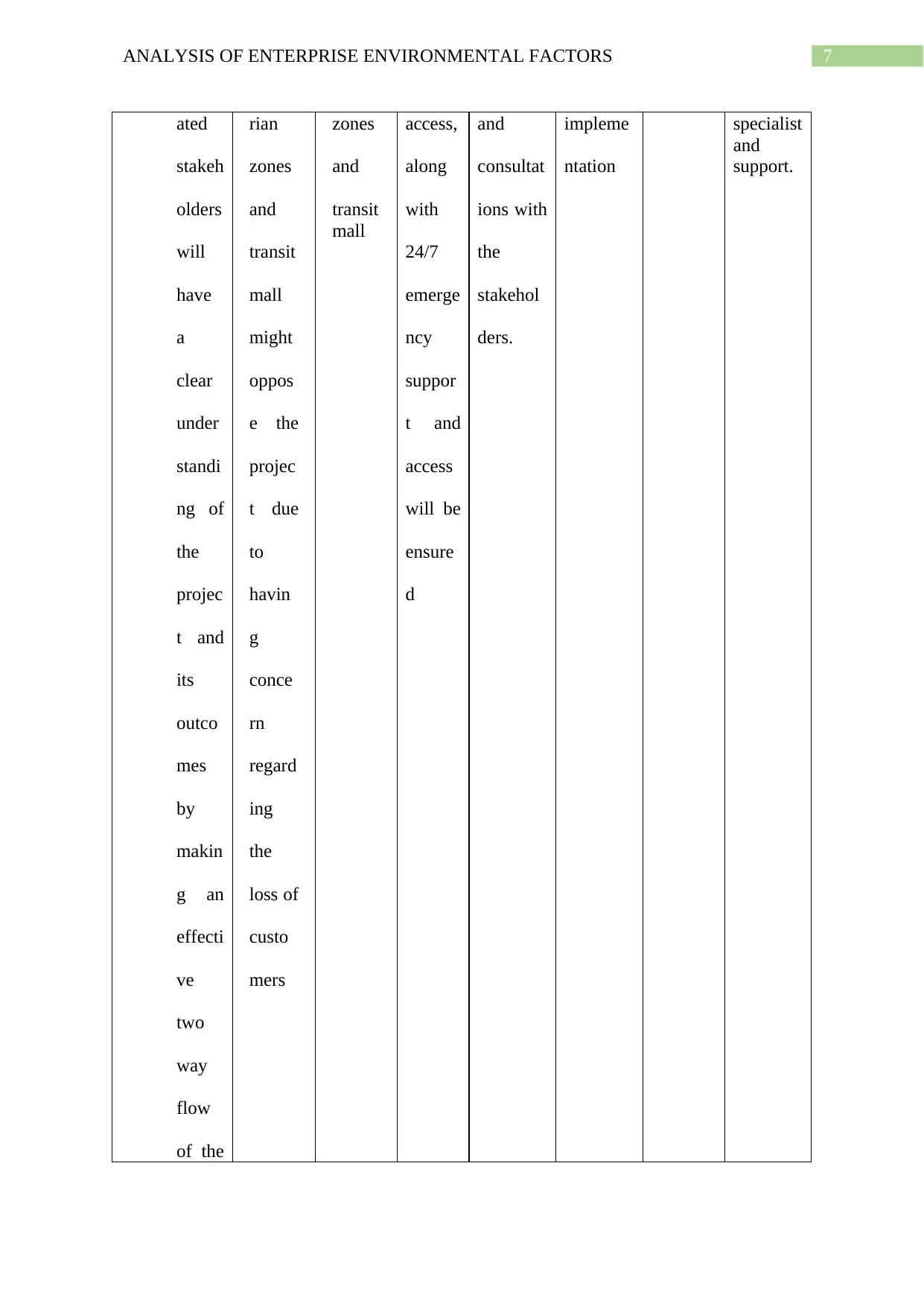
7ANALYSIS OF ENTERPRISE ENVIRONMENTAL FACTORS
ated
stakeh
olders
will
have
a
clear
under
standi
ng of
the
projec
t and
its
outco
mes
by
makin
g an
effecti
ve
two
way
flow
of the
rian
zones
and
transit
mall
might
oppos
e the
projec
t due
to
havin
g
conce
rn
regard
ing
the
loss of
custo
mers
zones
and
transit
mall
access,
along
with
24/7
emerge
ncy
suppor
t and
access
will be
ensure
d
and
consultat
ions with
the
stakehol
ders.
impleme
ntation
specialist
and
support.
ated
stakeh
olders
will
have
a
clear
under
standi
ng of
the
projec
t and
its
outco
mes
by
makin
g an
effecti
ve
two
way
flow
of the
rian
zones
and
transit
mall
might
oppos
e the
projec
t due
to
havin
g
conce
rn
regard
ing
the
loss of
custo
mers
zones
and
transit
mall
access,
along
with
24/7
emerge
ncy
suppor
t and
access
will be
ensure
d
and
consultat
ions with
the
stakehol
ders.
impleme
ntation
specialist
and
support.
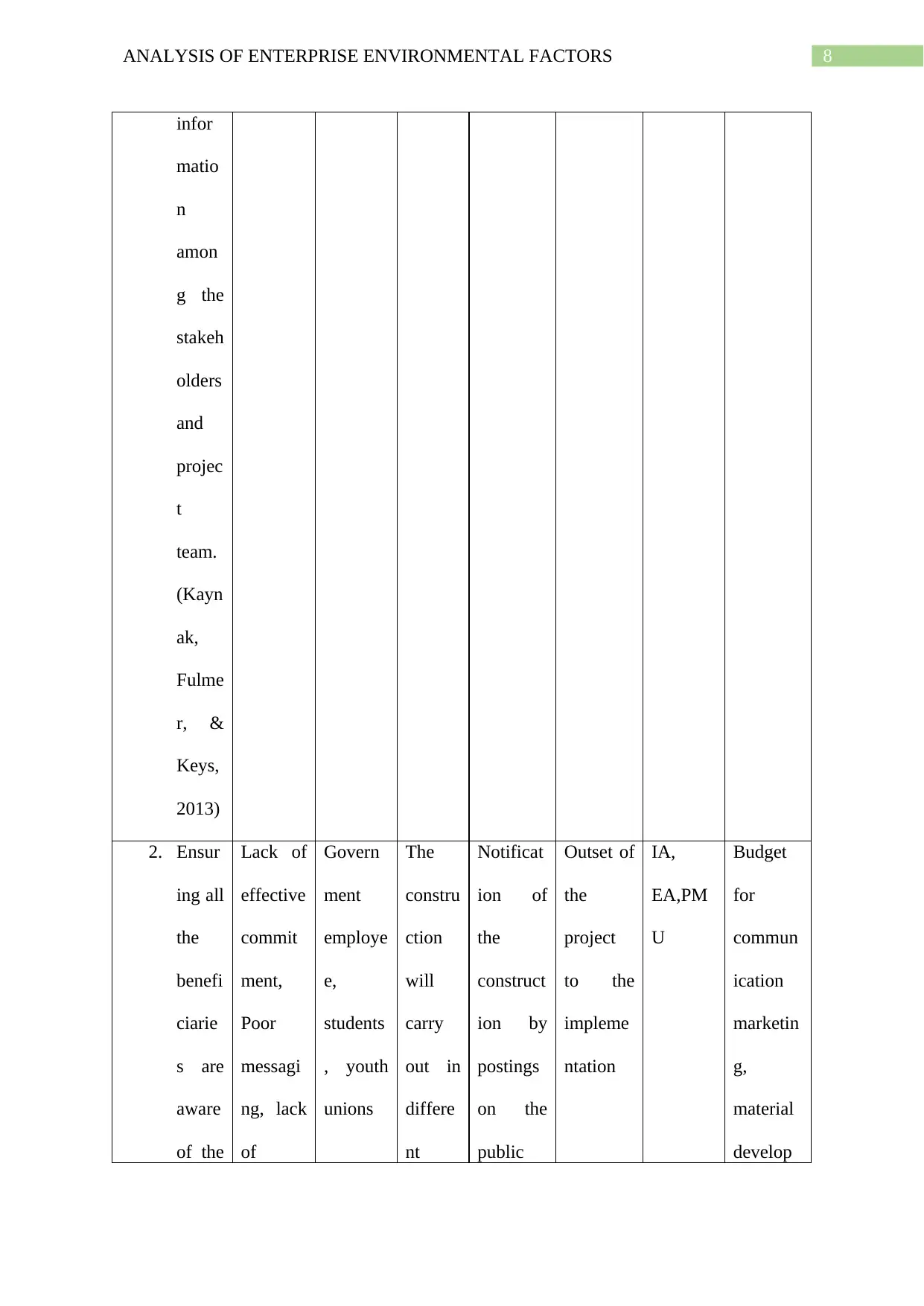
8ANALYSIS OF ENTERPRISE ENVIRONMENTAL FACTORS
infor
matio
n
amon
g the
stakeh
olders
and
projec
t
team.
(Kayn
ak,
Fulme
r, &
Keys,
2013)
2. Ensur
ing all
the
benefi
ciarie
s are
aware
of the
Lack of
effective
commit
ment,
Poor
messagi
ng, lack
of
Govern
ment
employe
e,
students
, youth
unions
The
constru
ction
will
carry
out in
differe
nt
Notificat
ion of
the
construct
ion by
postings
on the
public
Outset of
the
project
to the
impleme
ntation
IA,
EA,PM
U
Budget
for
commun
ication
marketin
g,
material
develop
infor
matio
n
amon
g the
stakeh
olders
and
projec
t
team.
(Kayn
ak,
Fulme
r, &
Keys,
2013)
2. Ensur
ing all
the
benefi
ciarie
s are
aware
of the
Lack of
effective
commit
ment,
Poor
messagi
ng, lack
of
Govern
ment
employe
e,
students
, youth
unions
The
constru
ction
will
carry
out in
differe
nt
Notificat
ion of
the
construct
ion by
postings
on the
public
Outset of
the
project
to the
impleme
ntation
IA,
EA,PM
U
Budget
for
commun
ication
marketin
g,
material
develop
⊘ This is a preview!⊘
Do you want full access?
Subscribe today to unlock all pages.

Trusted by 1+ million students worldwide
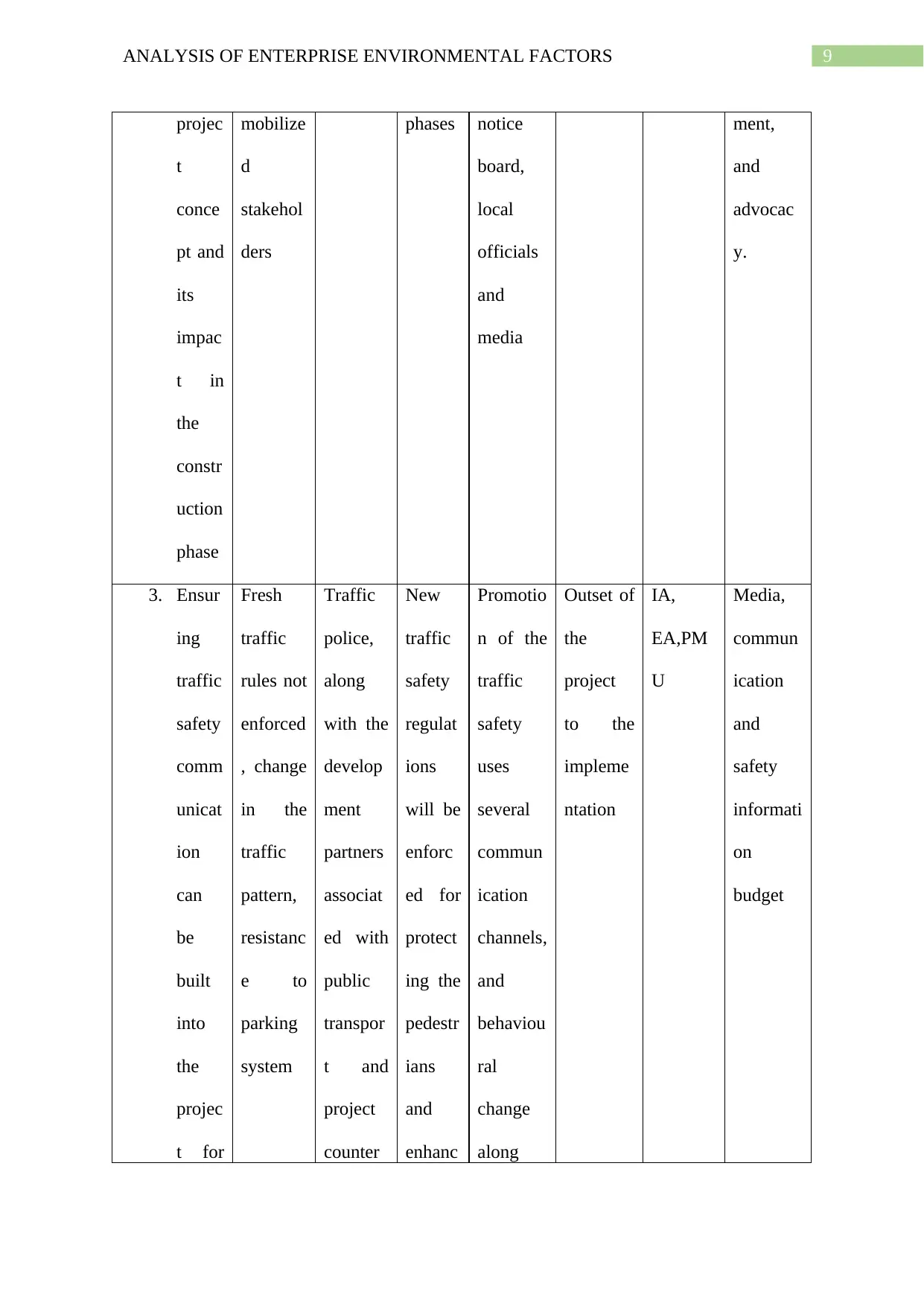
9ANALYSIS OF ENTERPRISE ENVIRONMENTAL FACTORS
projec
t
conce
pt and
its
impac
t in
the
constr
uction
phase
mobilize
d
stakehol
ders
phases notice
board,
local
officials
and
media
ment,
and
advocac
y.
3. Ensur
ing
traffic
safety
comm
unicat
ion
can
be
built
into
the
projec
t for
Fresh
traffic
rules not
enforced
, change
in the
traffic
pattern,
resistanc
e to
parking
system
Traffic
police,
along
with the
develop
ment
partners
associat
ed with
public
transpor
t and
project
counter
New
traffic
safety
regulat
ions
will be
enforc
ed for
protect
ing the
pedestr
ians
and
enhanc
Promotio
n of the
traffic
safety
uses
several
commun
ication
channels,
and
behaviou
ral
change
along
Outset of
the
project
to the
impleme
ntation
IA,
EA,PM
U
Media,
commun
ication
and
safety
informati
on
budget
projec
t
conce
pt and
its
impac
t in
the
constr
uction
phase
mobilize
d
stakehol
ders
phases notice
board,
local
officials
and
media
ment,
and
advocac
y.
3. Ensur
ing
traffic
safety
comm
unicat
ion
can
be
built
into
the
projec
t for
Fresh
traffic
rules not
enforced
, change
in the
traffic
pattern,
resistanc
e to
parking
system
Traffic
police,
along
with the
develop
ment
partners
associat
ed with
public
transpor
t and
project
counter
New
traffic
safety
regulat
ions
will be
enforc
ed for
protect
ing the
pedestr
ians
and
enhanc
Promotio
n of the
traffic
safety
uses
several
commun
ication
channels,
and
behaviou
ral
change
along
Outset of
the
project
to the
impleme
ntation
IA,
EA,PM
U
Media,
commun
ication
and
safety
informati
on
budget
Paraphrase This Document
Need a fresh take? Get an instant paraphrase of this document with our AI Paraphraser
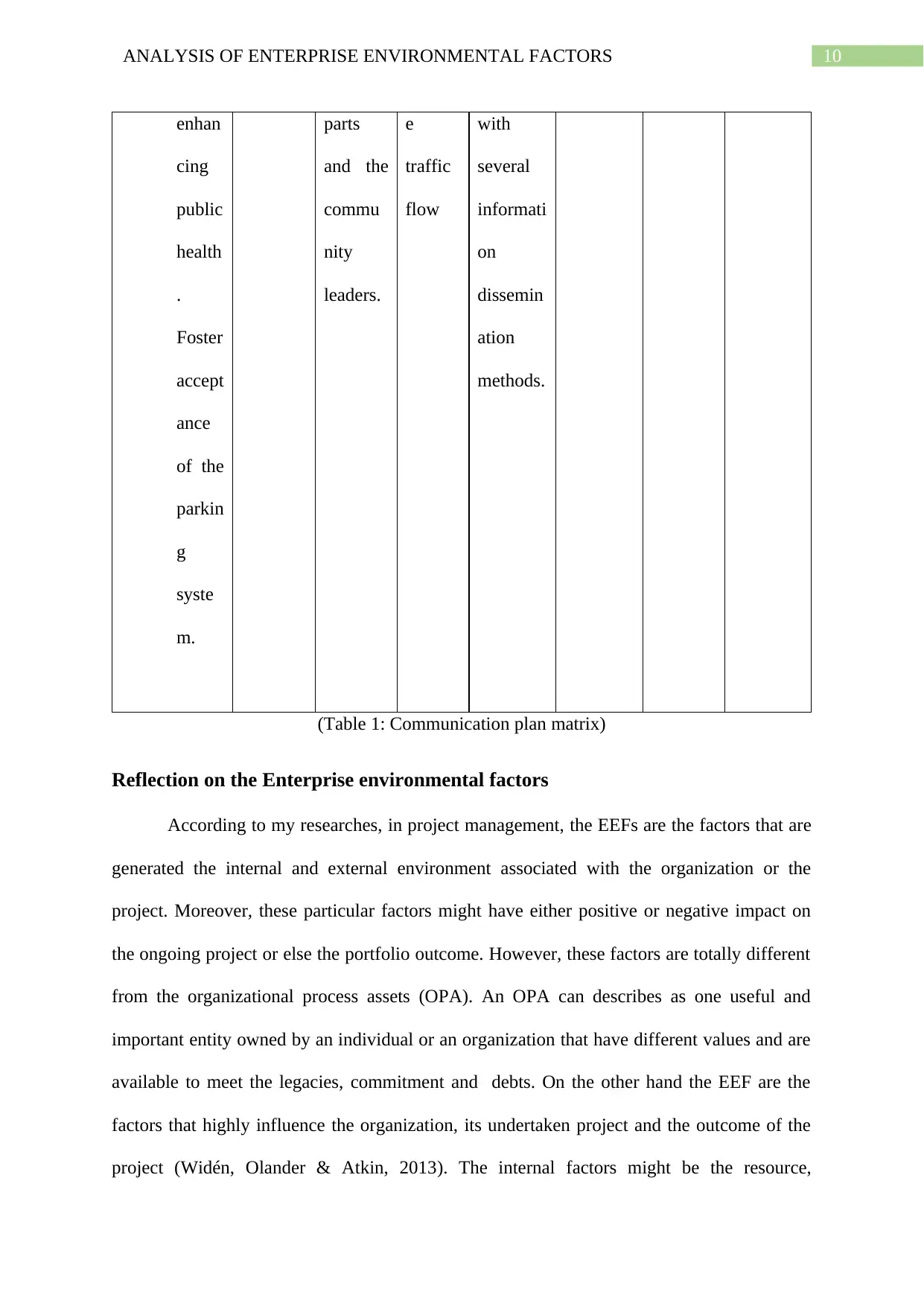
10ANALYSIS OF ENTERPRISE ENVIRONMENTAL FACTORS
enhan
cing
public
health
.
Foster
accept
ance
of the
parkin
g
syste
m.
parts
and the
commu
nity
leaders.
e
traffic
flow
with
several
informati
on
dissemin
ation
methods.
(Table 1: Communication plan matrix)
Reflection on the Enterprise environmental factors
According to my researches, in project management, the EEFs are the factors that are
generated the internal and external environment associated with the organization or the
project. Moreover, these particular factors might have either positive or negative impact on
the ongoing project or else the portfolio outcome. However, these factors are totally different
from the organizational process assets (OPA). An OPA can describes as one useful and
important entity owned by an individual or an organization that have different values and are
available to meet the legacies, commitment and debts. On the other hand the EEF are the
factors that highly influence the organization, its undertaken project and the outcome of the
project (Widén, Olander & Atkin, 2013). The internal factors might be the resource,
enhan
cing
public
health
.
Foster
accept
ance
of the
parkin
g
syste
m.
parts
and the
commu
nity
leaders.
e
traffic
flow
with
several
informati
on
dissemin
ation
methods.
(Table 1: Communication plan matrix)
Reflection on the Enterprise environmental factors
According to my researches, in project management, the EEFs are the factors that are
generated the internal and external environment associated with the organization or the
project. Moreover, these particular factors might have either positive or negative impact on
the ongoing project or else the portfolio outcome. However, these factors are totally different
from the organizational process assets (OPA). An OPA can describes as one useful and
important entity owned by an individual or an organization that have different values and are
available to meet the legacies, commitment and debts. On the other hand the EEF are the
factors that highly influence the organization, its undertaken project and the outcome of the
project (Widén, Olander & Atkin, 2013). The internal factors might be the resource,
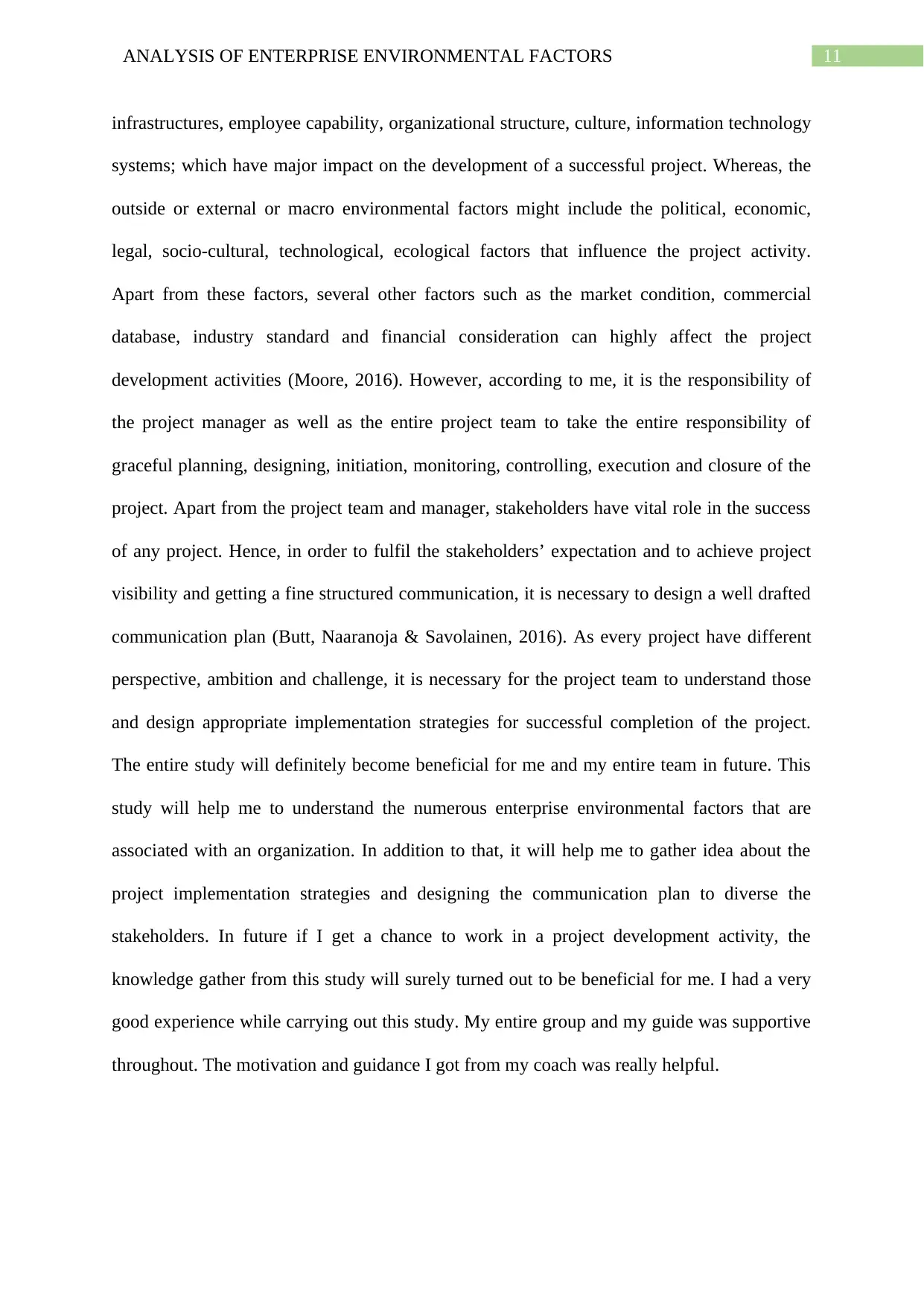
11ANALYSIS OF ENTERPRISE ENVIRONMENTAL FACTORS
infrastructures, employee capability, organizational structure, culture, information technology
systems; which have major impact on the development of a successful project. Whereas, the
outside or external or macro environmental factors might include the political, economic,
legal, socio-cultural, technological, ecological factors that influence the project activity.
Apart from these factors, several other factors such as the market condition, commercial
database, industry standard and financial consideration can highly affect the project
development activities (Moore, 2016). However, according to me, it is the responsibility of
the project manager as well as the entire project team to take the entire responsibility of
graceful planning, designing, initiation, monitoring, controlling, execution and closure of the
project. Apart from the project team and manager, stakeholders have vital role in the success
of any project. Hence, in order to fulfil the stakeholders’ expectation and to achieve project
visibility and getting a fine structured communication, it is necessary to design a well drafted
communication plan (Butt, Naaranoja & Savolainen, 2016). As every project have different
perspective, ambition and challenge, it is necessary for the project team to understand those
and design appropriate implementation strategies for successful completion of the project.
The entire study will definitely become beneficial for me and my entire team in future. This
study will help me to understand the numerous enterprise environmental factors that are
associated with an organization. In addition to that, it will help me to gather idea about the
project implementation strategies and designing the communication plan to diverse the
stakeholders. In future if I get a chance to work in a project development activity, the
knowledge gather from this study will surely turned out to be beneficial for me. I had a very
good experience while carrying out this study. My entire group and my guide was supportive
throughout. The motivation and guidance I got from my coach was really helpful.
infrastructures, employee capability, organizational structure, culture, information technology
systems; which have major impact on the development of a successful project. Whereas, the
outside or external or macro environmental factors might include the political, economic,
legal, socio-cultural, technological, ecological factors that influence the project activity.
Apart from these factors, several other factors such as the market condition, commercial
database, industry standard and financial consideration can highly affect the project
development activities (Moore, 2016). However, according to me, it is the responsibility of
the project manager as well as the entire project team to take the entire responsibility of
graceful planning, designing, initiation, monitoring, controlling, execution and closure of the
project. Apart from the project team and manager, stakeholders have vital role in the success
of any project. Hence, in order to fulfil the stakeholders’ expectation and to achieve project
visibility and getting a fine structured communication, it is necessary to design a well drafted
communication plan (Butt, Naaranoja & Savolainen, 2016). As every project have different
perspective, ambition and challenge, it is necessary for the project team to understand those
and design appropriate implementation strategies for successful completion of the project.
The entire study will definitely become beneficial for me and my entire team in future. This
study will help me to understand the numerous enterprise environmental factors that are
associated with an organization. In addition to that, it will help me to gather idea about the
project implementation strategies and designing the communication plan to diverse the
stakeholders. In future if I get a chance to work in a project development activity, the
knowledge gather from this study will surely turned out to be beneficial for me. I had a very
good experience while carrying out this study. My entire group and my guide was supportive
throughout. The motivation and guidance I got from my coach was really helpful.
⊘ This is a preview!⊘
Do you want full access?
Subscribe today to unlock all pages.

Trusted by 1+ million students worldwide
1 out of 15
Related Documents
Your All-in-One AI-Powered Toolkit for Academic Success.
+13062052269
info@desklib.com
Available 24*7 on WhatsApp / Email
![[object Object]](/_next/static/media/star-bottom.7253800d.svg)
Unlock your academic potential
Copyright © 2020–2025 A2Z Services. All Rights Reserved. Developed and managed by ZUCOL.





